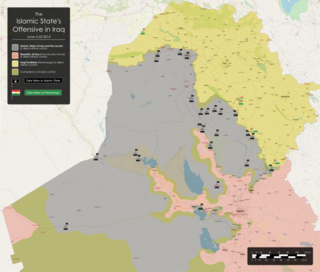
The Northern Iraq offensive began on 4 June 2014, when the Islamic State of Iraq and Levant, assisted by various insurgent groups in the region, began a major offensive from its territory in Syria into Iraq against Iraqi and Kurdish forces, following earlier clashes that had begun in December 2013 involving guerillas.
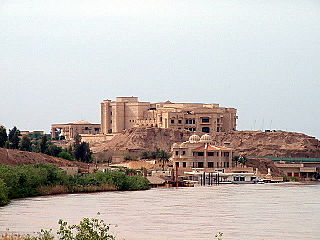
The First Battle of Tikrit was fought for the Iraqi city of Tikrit following the city's capture by the Islamic State and Ba'athist Loyalists during the 2014 Northern Iraq offensive. The battle took place between 26 and 30 June 2014.
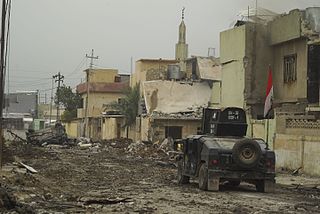
The War in Iraq (2013–2017) was an armed conflict between Iraq and its allies and the Islamic State. Following December 2013, the insurgency escalated into a full-scale civil war following clashes in the cities of Ramadi and Fallujah in parts of western Iraq, and culminated in the Islamic State offensive into Iraq in June 2014, which lead to the capture of the cities of Mosul, Tikrit and other cities in western and northern Iraq by the Islamic State. Between 4–9 June 2014, the city of Mosul was attacked and later fell; following this, Prime Minister Nouri al-Maliki called for a national state of emergency on 10 June. However, despite the security crisis, Iraq's parliament did not allow Maliki to declare a state of emergency; many legislators boycotted the session because they opposed expanding the prime minister's powers. Ali Ghaidan, a former military commander in Mosul, accused al-Maliki of being the one who issued the order to withdraw from the city of Mosul. At its height, ISIL held 56,000 square kilometers of Iraqi territory, containing 4.5 million citizens.

The departure of US troops from Iraq in 2011 ended the period of occupation that had begun with the U.S.-led invasion in March 2003. The time since U.S. withdrawal has been marked by a renewed Iraqi insurgency and by a spillover of the Syrian civil war into Iraq. By 2013, the insurgency escalated into a renewed war, the central government of Iraq being opposed by ISIL and various factions, primarily radical Sunni forces during the early phase of the conflict. The war ended in 2017 with an Iraqi government and allied victory, however ISIL continues a low-intensity insurgency in remote parts of the country.
The following lists events that happened during 2014 in Iraq.

The Iranian intervention in Iraq has its roots in the post-2003 invasion of Iraq by the United States and its allies, when the infrastructure of the Iraqi armed forces, as well as intelligence, were disbanded in a process called "de-Ba'athification" which allowed militias with close ties to Tehran to join the newly reconstituted army.

The Battle of Baiji took place in Baiji, Iraq, lasting from late October 2014 to late October 2015. In mid-November 2014, Iraqi forces retook the city of Baiji, and re-entered the Baiji Oil Refinery. However, fighting continued in the region, and on 21 December 2014, ISIL forces took Baiji and put the Baiji oil refinery under siege once again, before Iraqi forces recaptured the city on 22 October. It gave Iraqi forces complete control of the highway stretching from Baghdad to Baiji, and allowed Iraqi forces to use Baiji as a base for launching a future assault on Mosul.
The Battle of Ramadi, also called the Fall of Ramadi, was part of an ISIL offensive to capture all of the Anbar Province. Ramadi was one of the Iraqi government's last strongholds in Anbar, after ISIL's success in a previous campaign. The battle began in November 2014, and drew to a close on 14 May 2015, as Islamic State of Iraq and the Levant (ISIL) insurgents seized hold of government buildings following heavy house to house urban fighting. On 17 May, the Iraqi Army and special forces fled the city, with 500 civilians and security personnel dead.
This is a timeline of events during the War in Iraq in 2015.

The Second Battle of Tikrit was a battle in which Iraqi Security Forces recaptured the city of Tikrit from the Islamic State of Iraq and the Levant (ISIL). Iraqi forces consisted of the Iraqi Army and the Popular Mobilization Forces, receiving assistance from Iran's Quds Force officers on the ground, and air support from the American, British, and French air forces.
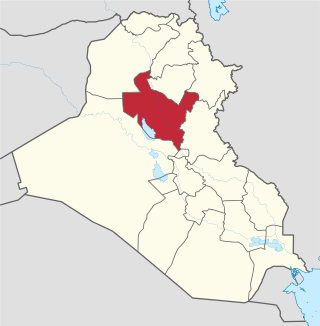
The Salahuddin Campaign was a military conflict in the Saladin Governorate, located in north-central Iraq, involving various factions fighting against a single common enemy, the Islamic State of Iraq and the Levant. The province exited Iraqi government control during ISIL's Northern Iraq offensive when large swathes of the north of the country were captured by the militant group with the Iraqi national army quickly disintegrating in the path of its advance. In light of the sweeping gains of the militants, Nouri Al-Maliki, the Prime Minister of Iraq at that time, attempted to declare a state of emergency though the Iraqi Parliament blocked his efforts to do so.
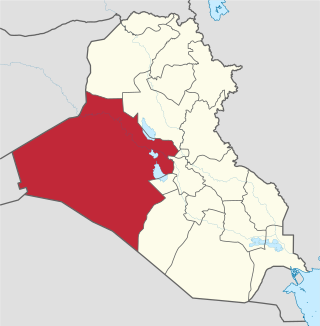
The Al-Karmah offensive, codenamed Fajr al-Karma, was an offensive launched by the Iraqi Army and anti-ISIL Sunni tribal fighters to recapture the Al-Karmah district taken by the Islamic State of Iraq and the Levant in Iraq. The offensive began on 14 April 2015. During the offensive the anti-ISIL forces captured part of the city of Al-Karmah, and the old road of Al-Karmah.
In early 2014, the jihadist group Islamic State of Iraq and the Levant captured extensive territory in Western Iraq in the Anbar campaign, while counter-offensives against it were mounted in Syria. Raqqa in Syria became its headquarters. The Wall Street Journal estimated that eight million people lived under its control in the two countries.
This article contains a timeline of events from January 2015 to December 2015 related to the Islamic State of Iraq and the Levant (ISIL/ISIS). This article contains information about events committed by or on behalf of the Islamic State, as well as events performed by groups who oppose them.
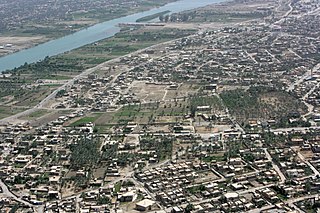
The Battle of Ramadi was a battle launched by the forces of Iraq to successfully recapture the city of Ramadi from the Islamic State of Iraq and the Levant (ISIL), which had taken the city earlier in 2015 in a previous battle. Air power was a major component of the battle, with the United States and other nations conducting over 850 airstrikes in the Ramadi area from July 2015 to late February 2016, and the US crediting airstrikes with 80% of the reason why the city was recaptured. By February 2016, Iraqi forces successfully recaptured the city after two and a half months of fighting. It was predicted that it would take several months to clear the city of the bombs ISIL left behind, with at least 9 months needed to clear the city's Tamim District. At the time, Ramadi had suffered more damage than any other city or town in Iraq with some estimates as high as 90% of the city being destroyed during the fighting.

The Anbar campaign (2015–2016) was a military campaign launched by the Iraqi Armed Forces and their allies aimed at recapturing areas of the Anbar Governorate held by the Islamic State of Iraq and the Levant (ISIL), including the city of Ramadi, which ISIL seized earlier in 2015. The United States and other nations aided Iraq with airstrikes.
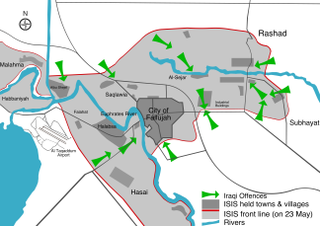
The siege of Fallujah was an offensive launched in February 2016 by the Iraqi government against the Islamic State of Iraq and the Levant (ISIL) in al-Karmah and in the city of Fallujah, with the aim of enforcing a siege of the latter. During the early stages of the operation, local Sunni residents revolted against ISIL for a period of three days. On 22 May, after completing preparations around the city, the Iraqi Army and supporting Shi'ite militias launched the third Battle of Fallujah.
The Battle of Hit, code named Operation Desert Lynx by Iraqi forces, was an offensive launched by the Iraqi Government during the Anbar offensive, with the goal of recapturing the town of Hīt and the Hīt District from ISIL. After the Iraqi forces recaptured the city of Ramadi, Hīt and Fallujah were the only cities still under the control of ISIL in the Al Anbar Governorate. Iraqi Forces fully recaptured Hīt and the rest of the Hīt District on 14 April 2016.
This is a timeline of events during the War in Iraq in 2016.

The Battle of Hawija was an offensive launched in September 2017 by the Iraqi Army, in order to recapture the town of Hawija and the surrounding areas from the Islamic State of Iraq and the Levant (ISIL).










